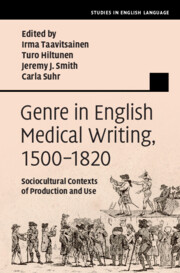Book contents
- Genre in English Medical Writing, 1500–1820
- Studies in English Language
- Genre in English Medical Writing, 1500–1820
- Copyright page
- Contents
- Figures
- Image Gallery
- Tables
- Notes on Contributors
- Preface
- Acknowledgements
- Chapter 1 Medical Discourse and Sociocultural Contexts 1500–1820
- Chapter 2 John Arderne’s Afterlife in Manuscript and Print
- Chapter 3 John Mirfield’s Gouernayl of Helþe
- Chapter 4 Surgical Handbooks Translated into Low German
- Chapter 5 Tracing the Early Modern John of Burgundy
- Chapter 6 The Plague in Southern Italy in 1815–1816
- Chapter 7 On Excitability
- Chapter 8 Systems and Centos
- Chapter 9 Medical Vocabulary in English Romantic Literature
- Chapter 10 Foreign Ingredients in Early and Late Modern English Recipes
- Chapter 11 Walter Bailey’s (1529–1593) Medical Genres
- Chapter 12 London Bills of Mortality of the Seventeenth Century
- Chapter 13 Advertising Proprietary Medicines in Pamphlets
- Chapter 14 Persuasion in Hungarian Medical Recipes
- Chapter 15 Persuasion in Early Modern English Medical Recipes
- Chapter 16 Richard III
- Chapter 17 Images and Paratexts
- Preface to the Image Gallery
- Image Gallery
- Index
- References
Chapter 9 - Medical Vocabulary in English Romantic Literature
Published online by Cambridge University Press: 13 October 2022
- Genre in English Medical Writing, 1500–1820
- Studies in English Language
- Genre in English Medical Writing, 1500–1820
- Copyright page
- Contents
- Figures
- Image Gallery
- Tables
- Notes on Contributors
- Preface
- Acknowledgements
- Chapter 1 Medical Discourse and Sociocultural Contexts 1500–1820
- Chapter 2 John Arderne’s Afterlife in Manuscript and Print
- Chapter 3 John Mirfield’s Gouernayl of Helþe
- Chapter 4 Surgical Handbooks Translated into Low German
- Chapter 5 Tracing the Early Modern John of Burgundy
- Chapter 6 The Plague in Southern Italy in 1815–1816
- Chapter 7 On Excitability
- Chapter 8 Systems and Centos
- Chapter 9 Medical Vocabulary in English Romantic Literature
- Chapter 10 Foreign Ingredients in Early and Late Modern English Recipes
- Chapter 11 Walter Bailey’s (1529–1593) Medical Genres
- Chapter 12 London Bills of Mortality of the Seventeenth Century
- Chapter 13 Advertising Proprietary Medicines in Pamphlets
- Chapter 14 Persuasion in Hungarian Medical Recipes
- Chapter 15 Persuasion in Early Modern English Medical Recipes
- Chapter 16 Richard III
- Chapter 17 Images and Paratexts
- Preface to the Image Gallery
- Image Gallery
- Index
- References
Summary
New resources have led to new insights into the history of English vocabulary. The appearance of machine-readable corpora has made it possible to contextualise particular idiolectal usages much more comprehensively than was possible until recently. Such developments have allowed, through the harnessing of the large bodies of data to be found in the Oxford English Dictionary and other resources, a much better understanding of intertextual engagement: what might be called authorial invention, the focus of this chapter. The chapter focuses on authorial invention during the Romantic period, with reference to three writers whose imaginative outputs drew profoundly on their understanding of medicine: Samuel Taylor Coleridge (1772–1834), Mary Shelley (1797–1851), and John Keats (1795–1821). As Richard Holmes has argued, Romanticism drew profoundly on its scientific inheritance, in the cases analysed here derived from direct or indirect encounters with thinkers such as Thomas Beddoes (1760–1808), Astley Cooper (1768–1841), William Cullen (1710–1790), and Erasmus Darwin (1731–1802). However, they transformed this inheritance through what Holmes terms ‘imaginative intensity’.
- Type
- Chapter
- Information
- Genre in English Medical Writing, 1500–1820Sociocultural Contexts of Production and Use, pp. 128 - 149Publisher: Cambridge University PressPrint publication year: 2022



